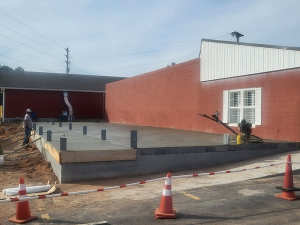Many concrete finishers have switched to synthetic fiber mesh reinforcement for concrete slabs to help reduce surface cracking. In doing so, many of these finishers have completely eliminated traditional welded wire mesh (WWM).
But while fiber mesh has advantages, it also comes with potentially costly drawbacks.
This may sound surprising, given fiber mesh’s big appeal is its time and money savings. By using it, finishers don’t have to pay a premium for WWM, and don’t have to take time to correctly install it. Some concrete finishers actually offer a price break for fiber mesh.
While fiber does reduce surface cracking, it won’t eliminate cracks completely. Worse, when a crack does develop, lack of WWM can be a real weakness.
This is because properly installed WWM will keep concrete on both sides of a crack from separating further and will keep them on the same plane— preventing differential settling. Fiber mesh won’t.
Repairs to differential settling don’t leave a great impression on new post frame building owners. You have to grind down the surface on either side of the crack, fill the gap with epoxy and try to smooth it all out. Even when done well, this leaves a visible scar.
While such scars are mostly cosmetic, they scream “poor workmanship” to clients, leading many to doubt the slab’s structural integrity.
As the use of fiber mesh has grown, more and more of these problems have been seen on job sites, however finishers are beginning to take notice. Soon after switching to fiber mesh, one found a dozen cracking and settling slabs at a given time. They reintroduced WWM and these problems virtually disappeared.
Chances of differential settling depends largely on underlying soils. Where soil is sandy and stable, settling is less likely and fiber alone can be a reasonable choice.
However, in areas with clay and other expansive soils, correcting problems caused by elimination of WWM can cost more in the long run than initial cost savings associated with fiber mesh.
In fact, the best way to minimize chances of cracking and settling is to use fiber mesh and WWM together.
Like any structural product, WWM won’t do its job unless it’s installed correctly. Unfortunately, this is not always done.
Proper installation to provide maximum strength requires mesh to be raised off the ground so when concrete sets, it is in the slab’s depth lower third. This means placing WWM on chairs to hold it at the correct height.
It is crucial to ensure WWM be placed on proper height chairs. Otherwise, WWM will not effectively hold the slab together.
 Wire not placed on chairs will not be effective. But in a rush to get jobs done, some crews eliminate chairs and roll WWM directly out over Code required under slab plastic sheeting covering underlying properly compacted fill. And when installers do use chairs, they must take care not to knock WWM off the chairs during pour. If they do, then they need to reset WWM.
Wire not placed on chairs will not be effective. But in a rush to get jobs done, some crews eliminate chairs and roll WWM directly out over Code required under slab plastic sheeting covering underlying properly compacted fill. And when installers do use chairs, they must take care not to knock WWM off the chairs during pour. If they do, then they need to reset WWM.
Making sure all of this gets done right can be a training and quality assurance challenge for finishers, and avoiding this challenge may be one reason why so many opt for synthetic fiber for these applications.
However, in soils or poorly prepared sites making settling likely, this type of oversight really needs to be a priority.






